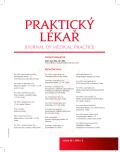Larva migrans cutanea – an imported skin disease and possibilities of treatment
Authors:
R. Rosoľanka; E. Nováková 1 2
Authors‘ workplace:
Univerzita Komenského v Bratislave
Jesseniová lekárska fakulta v Martine
; Klinika infektológie a cestovnej medicíny
Prednostka: prof. MUDr. Mária Szilágyiová, CSc.
1; Ústav mikrobiológie a imunológie
Vedúca: doc. MUDr. Elena Nováková, PhD.
2
Published in:
Prakt. Lék. 2016; 96(3): 149-151
Category:
Case Report
Overview
Larva migrans cutanea is a parasitic skin infection caused by the larvae of various helminths, mostly from the group of nematodes (roundworms). It is the most common skin disease of travelers returning from tropical and subtropical regions of the world. Human can become infected by contact with contaminated soil by the faeces of infected animals. Marine beach environment therefore exposes visitors to potential injury caused by the marine and terrestrial worms. In countries such as the Czech and Slovak Republic, the disease occurs only as imported from other countries in the world, the most common from a favorite holiday destinations. In addition to the presented case study in the article we are also dealing with the current treatment options of cutaneous larva migrans.
Keywords:
imported skin disease – larva migrans cutanea – current treatment options
Sources
1. Caumes E. Treatment of cutaneous larva migrans. Clin Infect Dis 2000; 30 : 811–814.
2. Knorr HL, Weber A. Ocular manifestation of selected zoonoses in humans. Tierarztl Prax 1992; 20(4): 347–354.
3. Chaundhry AZ, Lonworth DL. Cutaneous manifestations of intestinal helminthic infections. Dermatol Clin 1989; 7 : 275–290.
4. Šimeková K. Larva cutanea migrans ako importovaná nákaza z Thajska. Interná med 2006; 6(1): 25–27.
5. Jurado LF, Palacios DM, López R, et al. Cutaneous gnathostomiasis, first confirmed case in Colombia. Biomedica 2015; 35(4): 462–470.
6. Nevoralová Z. Larva migrans cutanea. Čas. Lék. čes. 2006; 145 : 325–326.
7. Caumes E, Carrière J, Guermonprez G, et al. Dermatoses associated with travel to tropical countries: a prospective study of the diagnosis and management of 269 patients presenting to atropical disease unit. Clin Infect Dis 1995; 20 : 542–548.
8. Šimeková K. Rickettsia conori – pôvodca infekcie importovanej z Juhoafrickej republiky. Prakt. Lék. 2005; 85(10): 573–574.
9. Šimeková K, Havlíčková I, Kořínková M. Vírusová hepatitída E ako importovaná nákaza. Slovenský lekár 2004; 14(9–10): 282–283.
10. Szilágyiová M, Nováková E, Šimeková K, a kol. Vírusová hepatitída E importovaná občanom SR z Vietnamu. Interná medicína 2010; 10(12): 214–215.
11. Šimeková K, Stejskal F, Lobovská A. Kožná leishmanióza importovaná občanom Českej republiky z Mexika. Slovenský lekár 2005 : 15(3–4): 66–67.
12. Kinčeková J, Dubinský P, Dvorožňáková E, a kol. Diagnostika a výskyt alveolárnej echinokózy na Slovensku. Česká a slovenská gastroenterologie a hepatologie 2005; 59(1): 11–16.
13. Davies HD, Sakuls P, Keystone JS. Creeping eruption: a review of clinical presentation and management of 60 cases presenting to a tropical disease unit. Arch Dermatol 1993; 129 : 588–591.
14. Vakil BJ, Bandisone MS, Gaitonde BB, et al. Clinical trials with a new antihelminthic, thiabendazole. J Trop Med Hyg 1955; 58 : 287–295.
15. Louis JF, De Quincenet G, Louis JP. Intérêt de l’ivermectine en prise unique dans le traitement du syndrome de larva migrans cutanée. Presse Med 1992; 21 : 1483.
16. Caumes E, Datry A, Paris L, et al. Efficacy of ivermectin in the therapy of cutaneous larva migrans. Arch Dermatol 1992; 128 : 994–995.
17. Caumes E, Carrière J, Datry A, et al. Efficacy of ivermectin in the therapy of cutaneous larva migrans: 57 cases (abstract K52). In: Proceedings of the 1st European Conference on Tropical Medicine (Hamburg, Germany). Oxford: Blackwell Science 1995.
18. van den Enden E, Stevens A, Van Gompel A. Treatment of cutaneous larva migrans. N Engl J Med 1998; 339 : 1246–1247.
19. Caumes E, Carrière J, Datry A, et al. A randomized trial of ivermectin versus albendazole for the treatment of cutaneous larva migrans. Am J Trop Med Hyg 1993; 49 : 641–644.
20. Albanese G, Venturi C, Galbiati G. Treatment of larva migrans cutanea (creeping eruption): a comparison between albendazole and traditional therapy. Int J Dermatol 2001; 40(1): 67–71.
21. Katz R, Ziegler J, Blank H. The natural course of creeping eruption and treatment with thiabendazole. Arch Dermatol 1965; 91 : 420–424.
Labels
General practitioner for children and adolescents General practitioner for adultsArticle was published in
General Practitioner

2016 Issue 3
Most read in this issue
- Fine motor skills disorders in general practice
- Larva migrans cutanea – an imported skin disease and possibilities of treatment
- New oral anticoagulants – a review
- Ankle brachial index and its interpretation in diabetic patients
